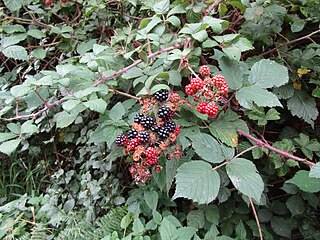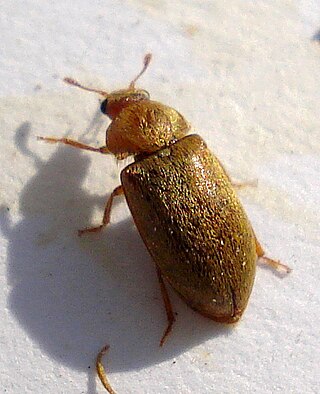
Rubus is a large and diverse genus of flowering plants in the rose family, Rosaceae, subfamily Rosoideae, with over 1,350 species, commonly known as brambles.

The raspberry is the edible fruit of a multitude of plant species in the genus Rubus of the rose family, most of which are in the subgenus Idaeobatus. The name also applies to these plants themselves. Raspberries are perennial with woody stems.

The raspberry beetle is a species of beetle in the fruitworm family Byturidae. It is a major pest that is widespread in north-central Europe, affecting raspberry, blackberry and loganberry plants.

Byturidae, also known as fruitworms, are small family of cleroid beetles with over 15 described species, primarily distributed in the Holarctic and Southeast Asia. The larvae of at least some genera feed on fruit, such as Byturus, a notable commercial pest of Rubus consuming both the fruit and seeds, while others like Xerasia are associated with catkins. The adults are known to feed on developing leaves, flowers and pollen.
Astata unicolor is a species of wasp in the family Crabronidae. It is found in Central America and North America.
Xerasia grisescens is a species of fruitworm beetle in the family Byturidae. It is found in North America.

Byturus is a genus of fruitworm beetles in the family Byturidae. There are five described species in Byturus.

Oberea perspicillata, the raspberry cane borer, is a species of flat-faced longhorn in the beetle family Cerambycidae. It is found in North America.

Agonoleptus is a genus of ground beetles in the family Carabidae. There are about eight described species in Agonoleptus.

Eubaphe unicolor is a species of geometrid moth in the family Geometridae. It is found throughout North America to South America.

Cicindela scutellaris, the festive tiger beetle, is a species of flashy tiger beetle in the family Cicindelidae. It is found in North America.
Gerstaeckeria unicolor is a species of hidden snout weevil in the beetle family Curculionidae.
Colopterus unicolor is a species of sap-feeding beetle in the family Nitidulidae. It is found in North America.
Scaphinotus unicolor is a species of ground beetle in the family Carabidae. It is found in North America.
Cerylon unicolor is a species of minute bark beetle in the family Cerylonidae. It is found in North America.
Boros unicolor is a species of conifer bark beetle in the family Boridae. It is found in North America.
Piazorhinus is a genus of true weevils in the beetle family Curculionidae. There are about eight described species in Piazorhinus.
Nosodendron unicolor, the slime flux beetle, is a species of wounded-tree beetle in the family Nosodendridae. It is found in North America.
Epipocus unicolor is a species of handsome fungus beetle in the family Endomychidae. It is found in Central America and North America.
Tritoma unicolor is a species of pleasing fungus beetle in the family Erotylidae. It is found in North America.








